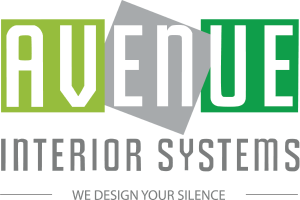Why this phenomenon can become a problem in your space
If you’ve spent much time on the Avenue Interior Systems website, you’ll know that we talk about reverberation quite a lot. So what exactly is reverberation? What issues does it cause, and what products help reduce reverberation in your spaces?
In terminology that’s a little easier to understand, reverberation is the persistence of a sound after it is produced. When a sound source ceases, the sound waves will continue to reflect off hard wall, floor and ceiling surfaces until they lose enough energy and die out. The continuation of the reflected sound is known as reverberation. The repeating, often low, booming sound that follows the strum of an electric guitar, or the thump of a bass drum, are reverberation.
Reverberation is a desirable property of halls, to the extent that it helps to overcome the inverse square law drop-off of sound intensity in the enclosure. However, if reverberation is excessive, it makes the sounds run together with a loss of articulation – the sound becomes muddy and garbled.
What is the difference between echo and reverberation?
An echo is usually clear and can be distinguished. Reverberation is not a precise replica of the original sound.
Reverberation time is the measure of the time it takes for reflecting sound to “fade away” in an enclosed area, after the source of the noise has stopped. Reverberation time is essential in defining how a room will perform acoustically.
Reverberation time reduces when the sound waves hit absorbent surfaces such as curtains, padded chairs or even people, or exit the room through the walls, drop ceilings, doors, and windows.
What’s the best way to solve a reverberation challenge?
Avenue Interior Systems are experts in reducing reverberation and improving the acoustics in a room. While some noise issues can be solved by just “turning down the volume”, this isn’t always practical. Just imagine trying to “turn down the volume” in a hall full of the primary school students, or older adults in a nursing home!
You can try and isolate the sound by putting a barrier around the sound to stifle it, so it is clearer for you to interact in a space. Again, this isn’t always practical; you could end up with each child or adult walking around wrapped in acoustic material!
The most practical way to deal with reverberation is to add absorption materials to a room. Ceiling tiles, sound absorption panels and other materials can control sound reflections and reduce reverberation within a space.
For challenges with speech intelligibility, controlling reflections that interfere with the direct speech path is important. Absorptive panels installed strategically throughout your space will improve speech intelligibility and lower general room noise.
Talk to Avenue for professional solutions to reverberation
If you have a reverberation issue in your office, hall or classroom, contact Avenue Interior Systems for a customised solution on 1300 827 177.
We look forward to designing your silence.



